|
This breed of pigeons is called the Banat Chicken Pigeon as the shape and size of these pigeons is similar to older chickens.
It has some resemblance to the Hungarian pigeon regarding its unusual shape and tail that is carried at an elevation of 45
degrees, but is lower then the Hungarian pigeon and has more refined appearance. Looking at this breed for the first time,
the most fanciers will admit that it reminds them of the old style Maltese pigeons. Today very little is actually known about
the origin of this breed and it is now impossible to definitely state how and when this beautiful pigeon is created. Generally,
it is believed it happened in the late nineteenth century through crosses of Maltese pigeons of that time and some other Hen
pigeons in the region of the Banat plain. What varieties of Hen pigeons were crossed to produce this pigeon is also disputed.
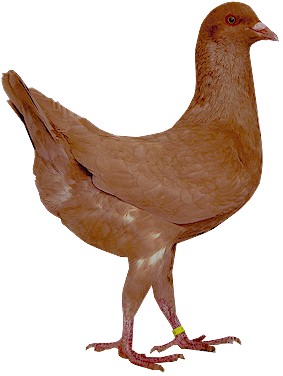
As the name itself implies, the Banat Chicken Pigeon comes from the area of the Banat plain. Located in the south east Europe
the Banat plain extends across west Romania, north-east Serbia, and south-east Hungary. It is bordered in the east by Transylvania
and Walachia, in the west by the Tisza River, in the north by the Muresul River, and in the south by the Danube. Except for
some eastern mountains, it is primarily an agricultural area of fertile, rolling plains. In Serbia, the Banat (Western Banat)
is mostly covered in plains. In former times, the most important feature of these rich plains were country farms known as
"salashes". The "salash" (farm) is property outside the village with building for living and with accessory
buildings, stables, barns, sheds etc. There people bred their livestock. Those "salashes" would be inconceivable
without pigeons because pigeons have been a part of the life of many of these people for generations. In former times, the
Banat Chicken pigeons were very common on these farms and at one point in the time they even became symbol of these farms
and farmsteads.
During the first half of the twentieth century, Banat Chicken pigeons were nothing more then an ordinary utility pigeons that
have been found in villages and the vicinity of country farms ''salashes'' all over the Banat county. At that time they were
mainly bred for commercial purposes because they were large enough to produce squabs of proper size to be useable at the table
and hard enough not to cause too much headache to the breeder. In those days pigeon breeding was very primitive. Pigeons
enjoyed freedom and lived in pretty much semi-wild state. They were inhabited in the attics of barns or houses where they
laid eggs and raised their youngsters. From their breeder they required minimum attention. They were fed in backyard together
with other poultry, usually in the morning, while the rest of day they would spent scouring the fields and cultivated lands
for extra food. During summer time pigeons had a lot of food in the fields, so they did not require any additional feeding.
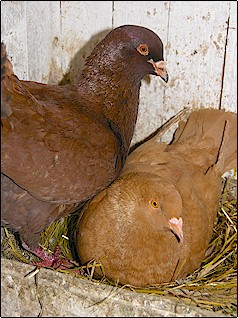
As it has been mentioned before, in former times, the Banat Chicken Pigeons were very common on the country farms '' salashes'',
but shortly after World War two, a great number of these farms was destroyed because of Communist dispossession of rich land
owners, but also because of theirs uncoordination with settlements. As a consequence many Banat Chicken Pigeons formerly
so common on these farms had disappeared with them. However, in the mid-fifties and in the early 1960's, they were still
very common and favorite pigeon breed in the Banat's villages. At that time they were bred not only because of their good
dietary meat but also because of the beauty of their figure and feathers. Still there was no standard of perfection to speak
of and there were hardly any exhibits. Each breeder bred them according to his own individual taste and because of that there
have been local varieties of Banat Chicken Pigeons. According to the stories of old breeders, the white and pied marking birds
were the most numerous at that time.
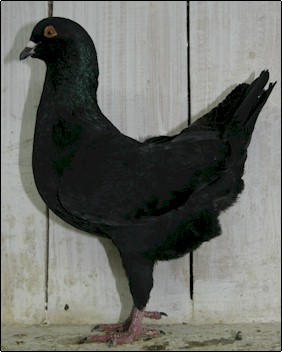
The late 1960s and early 1970s have brought decline in popularity of Banat Chicken Pigeons and little enthusiasm into the
hearts of many breeders. At that time Banat Chicken Pigeons were overshadowed by other more popular fancy breeds. Concequently,
many breeders sold off their stocks and changed over to the other fancy breeds. The Malteses were just one of them. In deed,
during 1970s the Maltese pigeons were among the most popular breeds in the Banat (Serbian part of Banat, formely know as
Yugoslav Banat). By this time Maltese pigeons were no longer capable of breeding their own offspring, as they tended to be
egg breakers and squab crushers, because of their extreme shape. Therefore breeders of Maltese pigeons were forced to keep
a good numbers of other, less elegant, but reliable brooding pigeons known under the name ,,feeders,, to nurse young Maltese
pigeons.
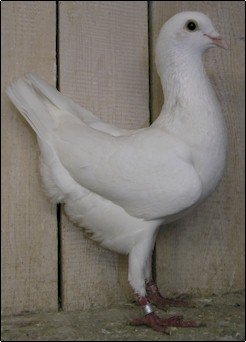
In those years, the Banat Chicken Pigeons were very often used along with Homers and Strassers as feeders of young Malteses,
because they were good feeders in the first pleace and since they did not enjoy great interest among breeders as a pure breed
they were relative inexpensive.
The most valued of all feeders were so called ,,semi-Malteses,,. Those semi-Malteses were crossbreed product of Banat
Chicken Pigeons and ,,ordinary,, ( low quality) Maltese pigeons. This crossbreeding become very popular especially among breeders
of Maltese pigeons because they prefered tall feeders as much as possible for their precious young Maltese pigeons. The result
of the popularity of these feeders was that good true Banat Chicken Pigeons became very scarse. Soon the pure booded Banat
Chicken Pigeons could be found in remaining country farms and in lofts of the few breeders that ramained faitful belivers
in the original breed. Thanks to the efforts of these few breeders who believed that the Banat Chicken Pigeon should be preserved
as the original breed as it was developed to be, it was saved from further croosbreeding and degradation.
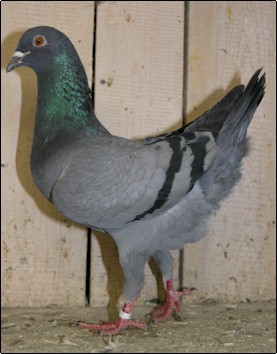
For a long time Banat Chicken Pigeons were not recognized as a breed and therefore could not be seen at pigeon shows. During
the last few decades they were unfairly deprecated as a pure breed, because they were ruined with crossing with Maltese pigeons.
In those years they were more or less considered as ''poor Maltese'' pigeons.
The standard for this breed in former Yugoslavia was introduced in 1981. From this point on, the appearance of Banat Chicken
Pigeon began to take more uniform appearance, especially during 1990s. The Yugoslav (now Serbian) standard classified them
as members of the Hen Pigeon group. They got official name in Serbian language ,,Banatski pilicasti golub,, or in English
,,Banat Chicken Pigeon'' or in German language "Banater Huhntauben". In former times these pigeons in Vojvodina
( Western Banat is part of Vojvodina, which is province of Serbia) were known under the name ''cirke'' (chirke) which is short
name from hungarian's name for these pigeons ''Magyar Csirkegalamb'' (it means Hungarian Chicken Pigeon), because once the
Banat region was under Hungarian government (in 1779 the Banat passed to Hungary, to which it belonged until 1918, except
for the brief period as an Austrian crown land). Even today in some parts of Vojvodina where Hungarian people are in majority
they still use that name for these pigeons.
For the many of you who have never seen a true Banat Chicken pigeon I shall try to describe this wonderful breed. In size
the Banat Chicken Pigeon is a mix of the German Modena and the Florentine. It is approximately 30 centimeters tall. The body
of these pigeons should be strong, not too long, horizontally carried. The breast should be broad, muscular, well rounded
and slightly convex. Head is large enough with a slightly raised forehead, without any ornaments. Eyes are large, whites should
have dark eyes, the other colors should have orange eyes. Eyes ceres should be red. Neck is medium length, stout and carried
vertical. Tail is short, uniform wide and should be carried at an elevation of 45 degrees. Wings are strong and held tight
to body,
the flights should lie on the tail with slight crossing. The legs must be of good length, but not too long, free of feathers,
strong and set wide. The length of legs is between 8 and 10 cm. Although an ideal weight is not specified with standard, a
good quality bird should weigh approximately 700 grams.
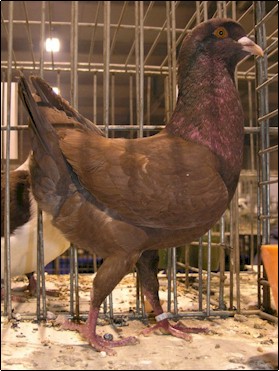
The Banat Chicken pigeon are bred in many colors including white, red, blue, yellow, black and many other nonstandard colors.
All colors have to be clear and intense. They are also bred in variety of patterns such as checkered, barred and pied marked.
Patterns and markings should be evenly distributed. At the present time, the most popular colors of Banat Chicken pigeons
among breeders are recessive red and yellow, and the best quality is currently in that two colors. The less popular and very
rare color is black. The level of other colors goes from moderate to high. The pied marked birds are also very popular among
fanciers. These birds usually have colored tail and colored spots on head and wing butts, while the remainder of the bird
is white. The pied marked pigeon always has bull eyes. An occasional black tiger and color tail birds may be seen. It is also
essential to know that several of the serious faults in Banat Chicken pigeons are that they have too small or too long body,
thin or long neck, horizontal tail, split or wry tail, lower wings, color without shine, irregular distributed patterns. In
judging the Banat Chicken Pigeon, the order of importance is as follows : overall appearance, size and type, wings and tail,
neck, head, legs, colors and patterns.
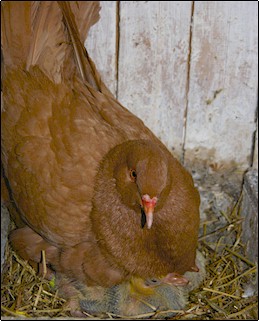
The Banat Chicken Pigeon is very friendly and companionable breed. The breed is excellent for beginning breeders and an individual
who has very limited free time because they can be bred with a minimum of problems. In the loft they do not require much space
and they can accommodate almost everywhere. Traditionally, fanciers from Vojvodina breed them in the attics of their houses
and barns. They do not use flying pens, but let their birds occasionally fly around and walk freely in gardens and yards,
where they enjoy all day in the sun and bath in the water (they really like to take bath). All what this kind of pigeon needs
in loft is deep and wide nest well padded with nest material because in the shallow ones it can be a little bit clumsy.
This breed is very modest in feeding, because it does not demand expensive mixture. The mixture usually contains three or
four components such as yellow corn, wheat, sunflower seed and green pea.
The Banat Chicken pigeon is very cheerful and tempered. In loft cocks cannot sit still. They will court another pigeons
with loud, enthusiastic coos. They love to parade and show themselves off when they are well acclimated to the loft. The Banat
Chicken pigeons are wonderful parents, willing to feed almost anything that squeaks. They are very fertile and prepared to
raise youngsters all the season, and you can expect eggs as long as they are not separated . A good pair of these pigeons,
well settled and well fed can produce up to twelve youngsters in one year, with an average weight of 500 grams. The youngsters
are hardy and easily reared. The Banat Chicken pigeons can be the best foster parents possible for other breeds that cannot,
such as Maltese, Pomeranian Pouter, English Pouter, Hungarian Giant House Pigeon and others. I have seen some fanciers that
use these pigeons even as foster parents for short faced breeds, such as Oriental Frill, Stapar and Novi Sad short faced pigeon.
Finally, I wish to state that this article is based upon my own personal experiences with Banat Chicken Pigeons and conversations
with other breeders of Banat Chicken Pigeons from Serbia. The pictures printed in this article are birds the author raised,
and by no means are meant to exemplify the perfect Banat Chicken Pigeon. I hope that this article has interested you. I will
greatly appreciate any comments on this article, either negative or positive.
Emilijan Lakic
laki1986@spinter.net
http://www.geocities.com/pigeon1986/main.htm
|

